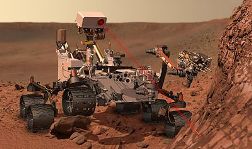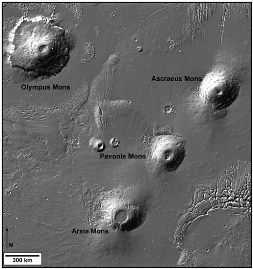 Twenty-twelve has been a year of firsts. A disabled man ran in the Olympic Games, Arctic Sea ice reached its lowest levels since records began, somehow Fifty Shades of Grey got published, and a robot tweeted at us from Mars. Jon Tennant & Sarah Day report.
Twenty-twelve has been a year of firsts. A disabled man ran in the Olympic Games, Arctic Sea ice reached its lowest levels since records began, somehow Fifty Shades of Grey got published, and a robot tweeted at us from Mars. Jon Tennant & Sarah Day report.
Geoscientist Online 27 September 2012
NASA’s latest mission, in which a three metre-long robot, Curiosity, landed on Mars, didn’t actually involve built-in ‘tweeting’ capability; but the Pasadena based account, which has over a million followers, has set the standard for extraterrestrial public engagement.
Until this mission, most of us have an idea of Mars developed from films. The best attempt at this is probably (the original, 1990) Total Recall : a rugged, barren wasteland, scorched red deserts, and the towering behemoth, Olympus Mons - minus the ex-Governor of California. But images of craters and little green men still abound. And when we did see pictures of the real thing, they were often from a distance or grainy, half-lit hints at a shadowy landscape.
What Curiosity has given us is arguably as important as the science itself – we now have exquisite, high-definition panoramas of the landing site, delivered to us via a twitter account as they are taken. We have direct access to information which, although it’s not coming directly from Curiosity, is updated by NASA in real time. It’s still 570 million kilometres away, but Mars has never seemed so close.
Dramatic
From its dramatic landing, Curiosity has documented every aspect of its journey to its followers. Often, the images include the rover itself – a kind of ‘self portrait’. These images don’t just give us a sense of scale. They remind us of the enormousness of Curiosity’s task, carrying out scientific experiments alone in a barren landscape.
Of course, long before Curiosity’s arrival, we had plenty of information about Mars, thanks to terrestrial geology, orbiting spacecraft and the adventures of previous rovers. We know about Mars’ atmosphere, its surface climate, that there is good evidence of a mobile fluid phase at some point in its history, and that it has the largest canyon system in the Solar System, Valles Marineris. From impact craters, we have been able to develop a layer-by-layer timeline of the planet’s geological evolution. Impacts reveal the ancient bedrock. And ejecta from impacts show potential evidence for volatiles, which could indicate the presence of sub-surface frozen water.
 We also know a lot about Mars’s topography. Tharsis, an immense volcanic province, covers a quarter of the planet’s surface, whilst slightly west (a mere few thousand kilometres) is Elysium, a smaller volcanic complex (only 2000 kilometres in diameter). The three main volcanoes here, Elysium Mons, Albor Tholus and Hecates Tholus are thought to have involved pyroclastics and lava during their development.
We also know a lot about Mars’s topography. Tharsis, an immense volcanic province, covers a quarter of the planet’s surface, whilst slightly west (a mere few thousand kilometres) is Elysium, a smaller volcanic complex (only 2000 kilometres in diameter). The three main volcanoes here, Elysium Mons, Albor Tholus and Hecates Tholus are thought to have involved pyroclastics and lava during their development.
Image: Tharsis: shaded relief image derived from Mars Orbiter Laser Altimeter data, which flew onboard the Mars Global Surveyor. The image shows Olympus Mons and the three Tharsis Montes volcanoes: Arsia Mons, Pavonis Mons, and Ascraeus Mons from southwest to northeast. Credit: NASA
Curiosity may not have enough time to explore distances that great, but it has already uncovered some intriguing details about the local geology. Landing in the 155km-wide Gale Crater, it began snapping the local terrain, and found what appears to be an angular unconformity in the layers of Mount Sharp (Aeolis Mons). Geologists are speculating from these early photographs that this horizon represents the interface between hydrated and non-hydrated rocks, or some form of hydraulic interaction. From photographs, the horizon certainly resembles erosional surfaces such as pediments, gently inclined surfaces truncating underlying bedrock. These typically form due to the action of free-flowing water. The geological history of these structures requires further investigation, and is one of the targets on Curiosity’s hit-list.
Geological Diversity
Curiosity is now on its way to Glenelg, at the foot of Mount Sharp. The location was chosen for its geological diversity and superficial similarity to clay-bearing deposits on Earth. On its way there, it has already seen rocks that show evidence of distinctly tilted bedding, and obvious signs of weathering and erosion. These could be anything from bedrock to lithified superficial sediments, but with higher priority targets to track down, these rocks have had to be left behind.
What’s fascinating about following the twitter account, rather than simply relying on NASA press releases, is how often the tweets focus on the rover itself. Photographs are frequently shots of the robot ‘doing science’, its own shadow passing over the planet’s surface, or just a particular aspect of its own machinery. It lends a strangely human feel to the project – if ever there were a manned mission to Mars, these are the sort of updates we’d expect. And, since they’re coming from the people who built Curiosity, they really can be viewed as the first human footprints on another planet, however remotely taken.
At Glenelg, Curiosity will look strictly for extrinsic evidence for life on Mars, not actual living or fossilised life-forms themselves. This means testing for habitable environments, by looking for evidence of a liquid water phase, potential sources of energy, organics, and other chemical constituents required for life to begin, evolve, and flourish.
Ownership
The only setback so far is the suspicion that one of Curiosity’s instruments was contaminated on Earth, and could now be covered in bacterial spores. These could only be of a type tough enough to survive the freezing temperatures, poisonous atmosphere, and intense ultraviolet radiation in Gale Crater, but they still mean that any water, liquid or ice Curiosity goes on to find will have to be analysed from a distance. Of course, for most of the rover’s million twitter followers, finding out what we know about Mars’ climate, surface and history isn’t the main attraction. Yes, Curiosity’s majority audience would be captivated by discoveries relating to past life forms, but that’s probably not the reason they’re following either. What the @MarsCuriosity account is doing is much simpler than that. It’s giving people access to, and a sense of ownership of, a project which in previous generations would have seemed – quite literally – remote.
It’s worth remembering the Curiosity, currently the star of the show, is the latest in a long line of predecessors. It might not have its own twitter account, but Opportunity has been investigating the surface of Mars now for eight and a half years, well beyond its original life expectancy. Although not as well equipped as Curiosity, Opportunity has uncovered a wealth of information about the geology of Mars, and continues to do so. And spare a thought for Spirit, Opportunity’s sister rover, which lost communication with Earth in March 2010. RIS.
The worlds of science and social media move fast. Already, Curiosity’s successor, InSight, has been announced. Who knows what means of communication NASA will have available to them by the time it launches?
In the meantime, we are content to be fed live updates of Curiosity driving around Mars, blasting rocks with lasers, paparazzo-ing geology and replying to its followers' many, many questions. We don’t need to watch bad sci-fi films to see Mars any more. We have our very own correspondent.
- Jon Tennant has been working as a Policy Intern at the Society during 2012. He leaves this week to take up a PhD project at Imperial College London.